Mutual Effect of Components of Protective Films Applied on Copper and Brass from Octadecylamine and 1,2,3-Benzotriazole Vapors
Abstract
:1. Introduction
- -
- It was shown that a CIN comprising an ODA + BTA mixture efficiently protects steel from atmospheric corrosion and can be used for the temporary protection of metal items;
- -
- The optimal temperature of chamber treatment (TCT) and its duration (τCT) required to form nanoscale adsorption films on the steel surface in order to stabilize the metal passive state were determined;
- -
- It was found that the ODA + BTA mixture is superior to ODA or BTA alone in the protective aftereffect (PAE), but estimation of the mutual effect of the mixture components indicates their antagonism;
- -
- The protection of steel with ODA, BTA and their mixtures was found to occur by a mixed (blocking-activation) mechanism;
- -
- It was shown that chamber treatment (CT) of steel with an ODA + BTA mixture resulted in surface hydrophobization or superhydrophobization if a polymodal surface was created on steel before the CT.
2. Materials and Methods
3. Results
3.1. Copper
3.1.1. Accelerated Tests
3.1.2. Ellipsometry
3.1.3. Voltametric Experiments
3.1.4. Electrochemical Impedance Spectroscopy (EIS)
3.1.5. Contact Angle Measurement
3.2. Brass
3.2.1. Accelerated Corrosion Tests
3.2.2. Ellipsometry
3.2.3. Voltametric Experiments
3.2.4. Electrochemical Impedance Spectroscopy
3.2.5. Wetting Angle Measurement
4. Conclusions
- A CIN consisting of an ODA + BTA mixture well protects copper and brass from atmospheric corrosion and can be used to temporarily protect metal items.
- The optimum temperature of CT with the mixed inhibitor is 120 °C for brass and 100 °C for copper. Treatment in its vapors for 1 h at these temperatures creates nanosized adsorption films on the surfaces of these metals. These films stabilize the passive state and provide efficient temporary protection of metal items.
- The protective effect of the ODA + BTA mixture is superior to that of its components. Assessment of their mutual effects indicates that there is an antagonism of the protective effect on copper and a synergistic enhancement in the case of brass.
- The results of impedance measurements make it possible to state that the protection of copper and brass by the CIN studied predominantly occurs by using the blocking mechanism.
- The most significant protective effect of the ODA + BTA formulation was found on brass. This effect is caused by the formation of adsorption films of considerable thickness that have high resistance to ion transfer from the electrolyte to the metal surface and, at the same time, strongly inhibit the Faraday process of metal oxidation.
- Chamber treatment of the metals studied with the ODA + BTA mixture results in surface hydrophobization that is significant on copper but insignificant on brass. Chamber treatment of copper samples with an artificially created polymodal surface makes the latter superhydrophobic.
Author Contributions
Funding
Institutional Review Board Statement
Data Availability Statement
Conflicts of Interest
References
- Rozenfel’d, I.L.; Persiantseva, V.P. Inhibitors of Atmospheric Corrosion; Nauka: Moscow, Russia, 1985; 278p. (In Russian) [Google Scholar]
- Ansari, F.A.; Verma, C.; Siddiqui, Y.S.; Ebenso, E.E.; Quraishi, M.A. Volatile corrosion inhibitors for ferrous and non-ferrous metals and alloys: A review. Int. J. Corros. Scale Inhib. 2018, 7, 126–150. [Google Scholar] [CrossRef]
- Gangopadhyay, S.; Mahanwar, P.A. Recent developments in the volatile corrosion inhibitor (VCI) coatings for metal: A review. J. Coat. Technol. Res. 2018, 15, 789–807. [Google Scholar] [CrossRef]
- Andreev, N.N.; Kuznetsov, Y.I. Physicochemical aspects of the action of volatile metal corrosion inhibitors. Russ. Chem. Rev. 2005, 74, 685. [Google Scholar] [CrossRef]
- Valdez, B.; Schorr, M.; Cheng, N.; Beltran, E.; Salinas, R. Technological applications of volatile corrosion inhibitors. Corros. Rev. 2018, 36, 227–238. [Google Scholar] [CrossRef]
- Bastidas, D.M.; Cano, E.; Mora, E.M. Volatile corrosion inhibitors: A review. Anti-Corros. Methods Mater. 2005, 52, 71–77. [Google Scholar] [CrossRef] [Green Version]
- Andreev, N.N.; Goncharova, O.A.; Kuznetsov Yurii, I.; Yu Luchkin, A. A Method for Metal Protection from Atmospheric Corrosion. RF Patent 2649354, 2 April 2018. (In Russian). [Google Scholar]
- Goncharova, O.A.; Luchkin, A.Y.; Archipushkin, I.A.; Andreev, N.N.; Kuznetsov, Y.I.; Vesely, S.S. Vapor-phase protection of steel by inhibitors based on salts of higher carboxylic acids. Int. J. Corros. Scale Inhib. 2019, 8, 586–599. [Google Scholar] [CrossRef]
- Goncharova, O.A.; Luchkin, A.Y.; Andreev, N.N.; Andreeva, N.P.; Vesely, S.S. Triazole derivatives as chamber inhibitors of copper corrosion. Int. J. Corros. Scale Inhib. 2018, 7, 657–672. [Google Scholar] [CrossRef]
- Goncharova, O.A.; Andreev, N.N.; Luchkin, A.Y.; Kuznetsov, Y.I.; Andreeva, N.P.; Vesely, S.S. Protection of copper by treatment with hot vapours of octadecylamine, 1,2,3-benzotriazole and their mixtures. Mater. Corros. 2019, 70, 161–168. [Google Scholar] [CrossRef] [Green Version]
- Luchkin, A.Y.; Goncharova, O.A.; Arkhipushkin, I.A.; Andreev, N.N.; Kuznetsov, Y.I. The effect of oxide and adsorption layers formed in 5-chlorobenzotriazole vapors on the corrosion resistance of copper. J. Taiwan Inst. Chem. Eng. 2020, 117, 231–241. [Google Scholar] [CrossRef]
- Goncharova, O.A.; Luchkin, A.Y.; Andreeva, N.P.; Kasatkin, V.E.; Vesely, S.S.; Andreev, N.N.; Kuznetsov, Y.I. Mutual Effects of Components of Protective Films Applied on Steel in Octadecylamine and 1,2,3-Benzotriazole Vapors. Materials 2021, 14, 7181. [Google Scholar] [CrossRef]
- GOST 859-2014; Copper. Grades. Rosstandart: Moscow, Russia, 2014.
- GOST 15527-2004; Pressure Treated Copper Zinc Alloys (Brasses). Grades. Rosstandart: Moscow, Russia, 2004.
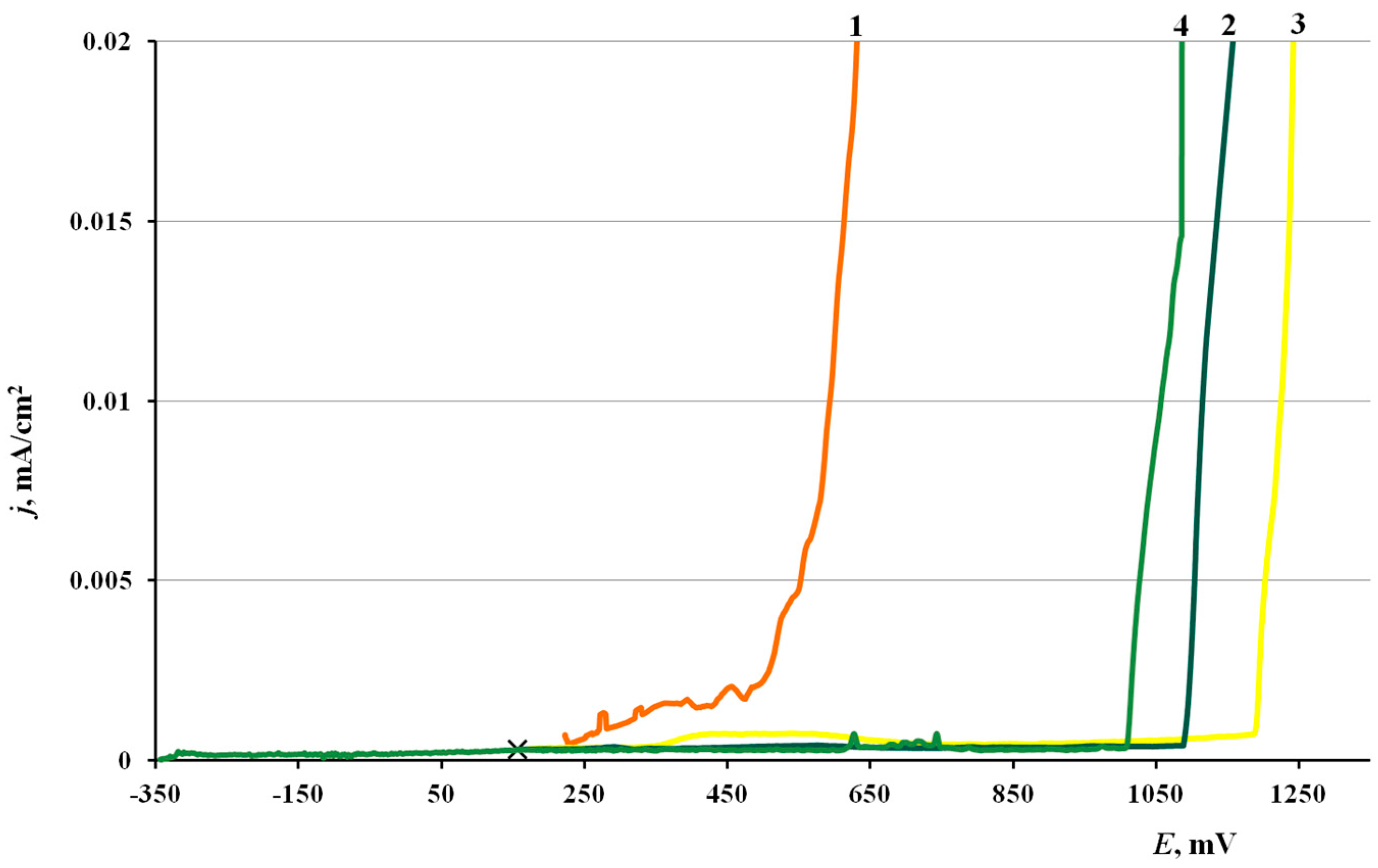
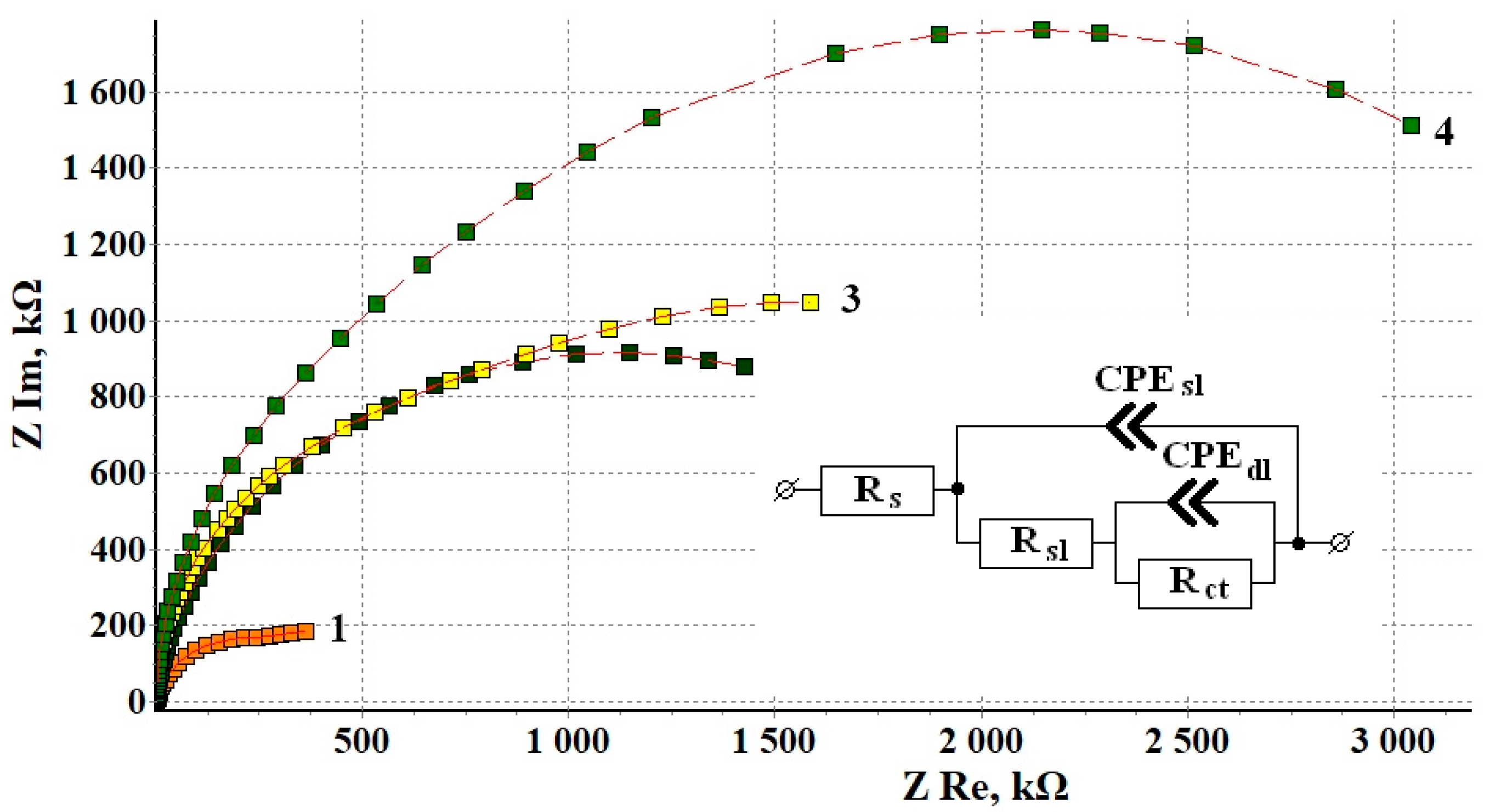
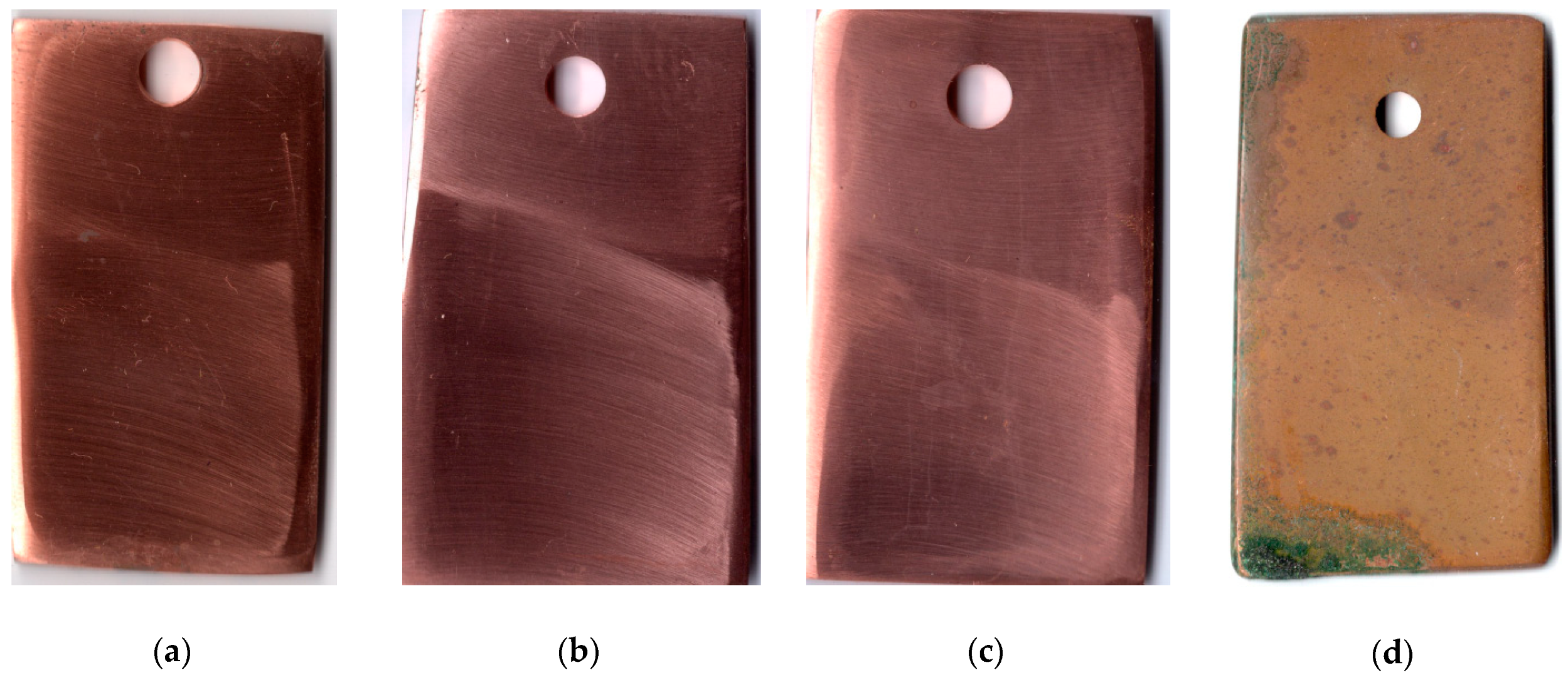
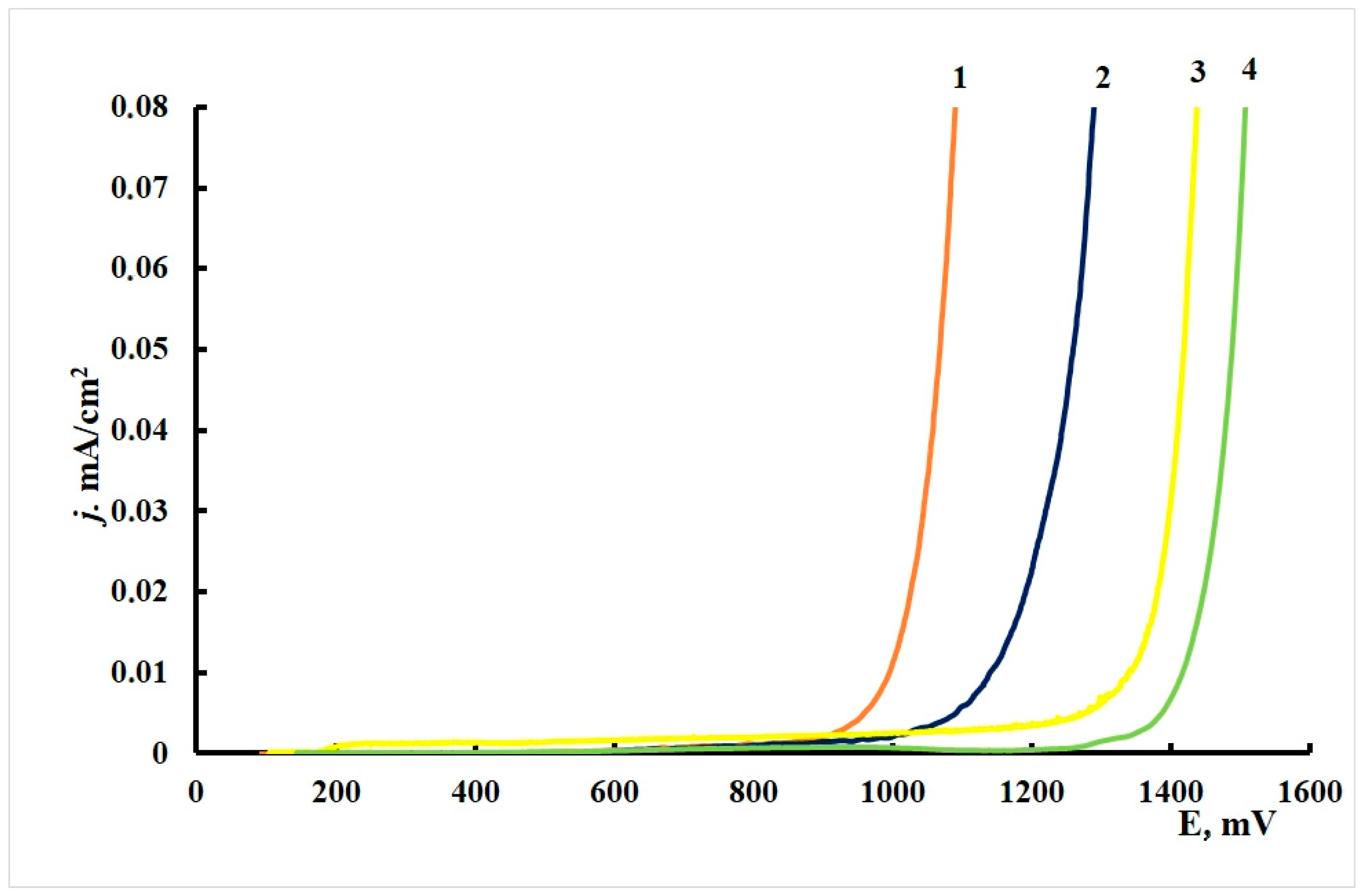

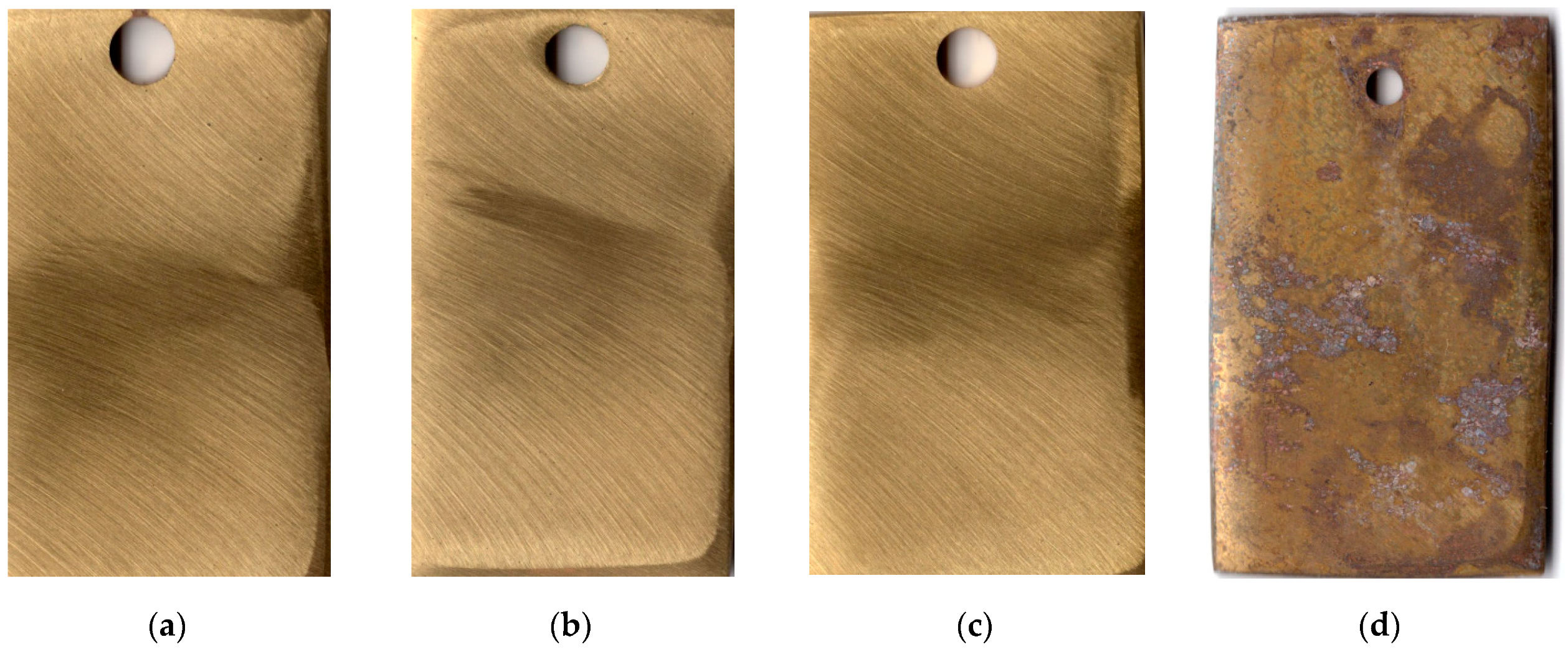
| Chamber Inhibitor | Time until Corrosion Damage Became Visible, h, after Chamber Treatment at the Following Temperatures: | |||
|---|---|---|---|---|
| 80 °C | 100 °C | 120 °C | 140 °C | |
| No CIN | 4.0 | 4.0 | - * | - * |
| BTA | 456 | 960 | - * | - * |
| ODA | 288 | 1080 | - * | - * |
| ODA + BTA | 3576 | 4800 | - * | - * |
| Chamber Inhibitor | Time until the Appearance of Corrosion Damage and Cycles after Chamber Treatment for Specified Period | ||
|---|---|---|---|
| 20 min | 40 min | 60 min | |
| No CIN | 2 | 2 | 2 |
| BTA | 15 | 15 | 14 |
| ODA | 14 | 17 | 24 |
| ODA + BTA | 15 | 15 | 15 |
| Chamber Inhibitor | Thickness d, nm | |
|---|---|---|
| Oxide Film | Adsorbed CIN Film | |
| No CIN | 4.5 ± 0.5 | - |
| BTA | 1.5 ± 0.5 | 2.0 ± 0.5 |
| ODA | 1.5 ± 0.5 | 3.5 ± 0.5 |
| ODA + BTA | 1.5 ± 0.5 | 4.5 ± 0.5 |
| Chamber Inhibitor | Ecor, V | Epit, V | Ebr, V |
|---|---|---|---|
| Without a CIN | 0.225 | 0.270 | 0.510 |
| BTA | 0.156 | - | 1.095 |
| ODA | 0.160 | - | 1.200 |
| ODA + BTA | −0.344 | 0.600 | 1.015 |
| Chamber Inhibitor | Rs kΩ·cm2 | Rsl kΩ·cm2 | CPEsl A, Ssn/cm2 | CPEsl nsl | Rct kΩ·cm2 | CPEdl A, Ssn/cm2 | CPEdl ndl | Protection Z, % |
|---|---|---|---|---|---|---|---|---|
| No CIN | 0.4 | 386.85 | 9.78 × 10−7 | 0.87 | 215.57 | 9.35 × 10−6 | 1 | |
| BTA | 0.33 | 513.66 | 2.86 × 10−7 | 0.98 | 1895.94 | 2.64 × 10−7 | 0.79 | 89.44 |
| ODA | 0.48 | 1506.41 | 2.09 × 10−7 | 1 | 1113.54 | 9.37 × 10−7 | 1 | 90.29 |
| ODA + BTA | 0.41 | 2263.29 | 1.45 × 10−7 | 0.99 | 1655.61 | 3.19 × 10−7 | 1 | 93.51 |
| Chamber Inhibitor | γsl | γct |
|---|---|---|
| BTA | 1.33 | 8.80 |
| ODA | 3.89 | 5.17 |
| ODA + BTA | 5.85 | 7.68 |
| Chamber Inhibitor | Contact Angle, Degree |
|---|---|
| No CIN | 75 |
| BTA | 107 |
| ODA | 104 |
| ODA + BTA | 112 |
| ODA + BTA, polymodal surface | 160 |
| Chamber Inhibitor | Time until the Appearance of Corrosion Damage, h, after Chamber Treatment at Temperature: | |||
|---|---|---|---|---|
| 80 °C | 100 °C | 120 °C | 140 °C | |
| No CIN | 2.0 | 2.0 | 2.0 | - * |
| BTA | 2.0 | 5.0 | 5.0 | - * |
| ODA | 2.0 | 2.0 | 2.0 | - * |
| ODA + BTA | 24 | 1416 | 2232 | - * |
| Chamber Inhibitor | Time until Corrosion Damage Appeared, Cycles, after Chamber Treatment for a Period of: | |||
|---|---|---|---|---|
| 15 min | 30 min | 60 min | 75 min | |
| No CIN | 1 | 1 | 1 | - * |
| BTA | 1 | 1 | 1 | - * |
| ODA | 1 | 1 | 1 | - * |
| ODA + BTA | 3 | 5 | 15 | - * |
| Chamber Inhibitor | Thickness d, nm | |
|---|---|---|
| Oxide Film | Adsorbed CIN Film | |
| No CIN | 3.25 ± 0.25 | - |
| BTA | 3 ± 0.5 | 19 ± 2 |
| ODA | 1 ± 0.5 | 36 ± 1 |
| ODA + BTA | 2 ± 0.5 | 40 ± 1 |
| Chamber Inhibitor | Ecor, V | Epit, V |
|---|---|---|
| No CIN | 0.105 | 0.445 |
| BTA | 0.095 | 0.665 |
| ODA | 0.110 | 0.675 |
| ODA + BTA | 0.145 | 1.080 |
| Chamber Inhibitor | Rs KΩ·cm2 | Rsl KΩ·cm2 | CPEsl A, Ssn/cm2 | CPEsl nsl | Rct KΩ·cm2 | CPEdl A, Ssn/cm2 | CPEdl ndl | Protection Z, % |
|---|---|---|---|---|---|---|---|---|
| No CIN | 0.55 | 27.5 | 8.26 × 10−7 | 0.84 | 31.5 | 6.22 × 10−5 | 0.76 | |
| BTA | 0.47 | 227.4 | 3.82 × 10−7 | 1 | 1701 | 1.39 × 10−7 | 1 | 96.94 |
| ODA | 0.67 | 5255 | 1.47 × 10−8 | 0.98 | 11833 | 2.76 × 10−8 | 0.80 | 99.65 |
| ODA + BTA | 0.44 | 44257 | 3.61 × 10−8 | 0.97 | 27284 | 1.43 × 10−8 | 0.93 | 99.93 |
| Chamber Inhibitor | γsl | γct |
|---|---|---|
| BTA | 8.27 | 54 |
| ODA | 191 | 376 |
| ODA + BTA | 1609 | 866 |
| Chamber Inhibitor | Contact Angle, Deg. |
|---|---|
| Without a CIN | 85 |
| BTA | 88 |
| ODA | 92 |
| ODA + BTA | 93 |
| ODA + BTA, polymodal roughness | 146 |
Publisher’s Note: MDPI stays neutral with regard to jurisdictional claims in published maps and institutional affiliations. |
© 2022 by the authors. Licensee MDPI, Basel, Switzerland. This article is an open access article distributed under the terms and conditions of the Creative Commons Attribution (CC BY) license (https://creativecommons.org/licenses/by/4.0/).
Share and Cite
Goncharova, O.A.; Luchkin, A.Y.; Andreeva, N.P.; Kasatkin, V.E.; Vesely, S.S.; Andreev, N.N.; Kuznetsov, Y.I. Mutual Effect of Components of Protective Films Applied on Copper and Brass from Octadecylamine and 1,2,3-Benzotriazole Vapors. Materials 2022, 15, 1541. https://doi.org/10.3390/ma15041541
Goncharova OA, Luchkin AY, Andreeva NP, Kasatkin VE, Vesely SS, Andreev NN, Kuznetsov YI. Mutual Effect of Components of Protective Films Applied on Copper and Brass from Octadecylamine and 1,2,3-Benzotriazole Vapors. Materials. 2022; 15(4):1541. https://doi.org/10.3390/ma15041541
Chicago/Turabian StyleGoncharova, Olga A., Andrey Yu. Luchkin, Nina P. Andreeva, Vadim E. Kasatkin, Sergey. S. Vesely, Nikolay N. Andreev, and Yurii I. Kuznetsov. 2022. "Mutual Effect of Components of Protective Films Applied on Copper and Brass from Octadecylamine and 1,2,3-Benzotriazole Vapors" Materials 15, no. 4: 1541. https://doi.org/10.3390/ma15041541
APA StyleGoncharova, O. A., Luchkin, A. Y., Andreeva, N. P., Kasatkin, V. E., Vesely, S. S., Andreev, N. N., & Kuznetsov, Y. I. (2022). Mutual Effect of Components of Protective Films Applied on Copper and Brass from Octadecylamine and 1,2,3-Benzotriazole Vapors. Materials, 15(4), 1541. https://doi.org/10.3390/ma15041541






